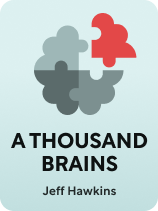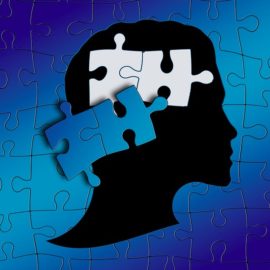

This article is an excerpt from the Shortform book guide to "A Thousand Brains" by Jeff Hawkins. Shortform has the world's best summaries and analyses of books you should be reading.
Like this article? Sign up for a free trial here.
Do you know how your brain really works? What if understanding our own intelligence could revolutionize artificial intelligence?
In A Thousand Brains: A New Theory of Intelligence, neuroscientist Jeff Hawkins presents a groundbreaking theory of human cognition. He explores how the brain’s neocortex creates mental models and makes predictions. This new framework offers insights into both human intelligence and potential advancements in AI.
Read on to discover how your brain’s “mini-brains” work together to create your understanding of the world.
Overview of A Thousand Brains: A New Theory of Intelligence
Modern technological progress is ablaze with the potential for artificial intelligence to revolutionize everything we do, and yet we still don’t fully understand how natural, human intelligence works. Computer pioneers and neuroscientists believe that by understanding how the human brain functions, we can use that knowledge to create even more powerful and useful intelligent machines. Cracking the code of human and machine intelligence has become one of the most significant challenges of our time.
In A Thousand Brains: A New Theory of Intelligence, published in 2022, neuroscientist Jeff Hawkins explores the workings of human cognition and presents a new theory of intelligence rooted in the ability of each separate component of the brain to create models of the world and make predictions, just as the brain does as a whole. Through this novel framework for understanding intelligence, Hawkins points to new possibilities for advancements in AI and offers insights into the nature of human cognition.
Hawkins is known for his groundbreaking work in the fields of mobile computing and brain theory. He is the cofounder of Palm Computing, where he developed the PalmPilot in 1996. Hawkins later founded Numenta, a neuroscience research company focused on developing a comprehensive theory of how the human brain works. In 2004, Hawkins wrote On Intelligence, which explores the intersection of neuroscience and AI.
In this overview, we’ll explore Hawkins’s theory that the brain’s neocortex—the seat of intelligence—is composed of thousands of copies of the same basic neural circuitry, each of which replicates the basic functions of the brain in microcosm. We’ll discuss how these circuits map the world around us, make predictions, and enable abstract thinking. We’ll then describe how this model of the brain could be used to advance AI research, the dangers inherent in AI development, and the benefits that AI systems based on human cognition could hold for the future.
How the Brain Works
To explain Hawkins’s ideas about how the human brain generates intelligence, we’ll have to explore how the brain works as a whole. We’ll cover how the brain’s newer structures (those that form what we call the neocortex) relate to its older, more primitive components. We’ll describe the fundamental building blocks of the neocortex, how they create mental models of the world, and how the same neural circuitry that lets us navigate our physical environment also gives us the capacity for abstract thought and contemplation.
Before Hawkins delves into his new theory of the brain, he takes a moment to review the older prevailing theory. The old model proposes that your brain processes sensory information, like vision and hearing, in a step-by-step manner like a flowchart. At the bottom of the chart, different nerves in your brain respond to simple features, such as lines and colors. As you move up the hierarchy, each new level of the brain responds to increasingly complex information from the regions below it.
Hawkins argues that, while this theory explains some early neuroscience findings, it treats sensing as a static, one-way process, ignoring how your movements and changing environment actively shape your perception. The “hierarchical” theory also can’t explain how your brain fills in gaps to create a cohesive understanding of the world from partial sensory data. Hawkins writes that while the hierarchy theory was a good model for brain research to work from, neuroscientists now recognize that it needs updating to incorporate the interactive, dynamic nature of perception.
The Thousand Brains Theory
Before going into detail about how the brain’s various components operate, let’s consider the high-level perspective. In essence, Hawkins’s theory is that the brain is composed of thousands of nearly identical information processing units from which our awareness and intelligence emerge. We’ll begin by describing the functions of these units, how each supports a fraction of the brain’s total function, and how they coordinate with each other.
Hawkins proposes that the neocortex, the part of your brain responsible for higher cognitive functions, consists of around 150,000 cortical columns that each act as a mini-brain. Each column receives inputs, builds mental models, and makes predictions just as the brain does as a whole. The coordinated activity of these thousands of mini-brains working together produces the complex cognition and awareness that your brain is capable of.
According to Hawkins’s theory, each mini-brain in the neocortex processes a specific aspect of sensory input. One cortical column might learn how an object feels, while another learns what noises it makes. No single column has a complete understanding of any given object or concept. Instead, your brain’s knowledge is distributed across thousands of these columns. This architecture makes the brain robust and resilient—it doesn’t depend on any individual neuron or cortical column to function. Rather, cognition emerges from the parallel, redundant processing of all the mini-brains working together. Your cortical columns are highly interconnected, allowing them to integrate their outputs into a unified whole.
Hawkins posits that each mini-brain communicates its findings to the rest, and through a process akin to voting, the cortical columns arrive at a consensus about what your senses detect and how you should react. Each column announces its perception and preferred reaction based on its individual input, and the brain’s overall response corresponds to the majority opinion of the columns. This produces what your conscious mind perceives as a unified experience despite the distributed nature of cortical processing.
The Old Brain and the New
Though the thousands of mini-brains that comprise your neocortex get all the credit for intelligent behavior, they’re far from the only important part of your brain. Instead, the neocortex is entirely dependent on the older, more primitive parts of your brain to interact with the outside environment at all. Here, we’ll expand on how the different parts of your brain interact, what functions the primitive parts of your brain perform, and how the two work together to build your understanding of the world.
Hawkins explains that the human brain is divided into two main parts—the Old Brain and the neocortex. From an evolutionary perspective, the Old Brain is ancient and is similar to that in many animal species. It’s responsible for maintaining your basic biological functions and reflexes. In contrast, the neocortex is a more recent evolutionary development. It’s much larger in humans than in other species, accounting for 70% of your brain and acting as the source of your intelligence. The neocortex processes sensory information and, in humans, is capable of complex cognitive functions such as language and mathematics.
The Old Brain’s Influence
Although your neocortex is where your higher thought processes reside, Hawkins writes that it doesn’t operate in isolation from your Old Brain. All sensory signals and motor commands must pass through the Old Brain before reaching the neocortex or being enacted by the body. Though the neocortex is divided into different regions that process specific types of information, such as vision, hearing, and language, these regions are highly interconnected. Every part of the neocortex is also connected to both the sensory inputs and the motor control areas of the Old Brain, indicating the close relationship between your senses, your thoughts, and your actions.
Hawkins is clear that the brain doesn’t process information in a linear, input-output fashion like a computer. Instead, the neocortex constantly makes predictions based on past experience and the Old Brain’s current sensory input. When predictions and inputs match, your neocortex strengthens its existing neural connections—such as when you judge how hard to toss a ball and it lands exactly on your target. When your neurons’ predictions are wrong, like when you miss when throwing a ball, your brain will form new neural connections to update its mental models of the world. This process of prediction and error correction is a fundamental aspect of how brains learn, and since all the neocortex’s information comes from the Old Brain, they have to work together to enable intelligent thought and decision-making.
Cortical Columns
From the high-level view of the brain, let’s zoom in on the neocortex. In a way, the neocortex looks like a crumpled-up towel, but if you were to flatten it out, you’d see that it’s a single sheet made of layers of nerve cells. Looking even closer at the flattened neocortex, we’ll find that it’s chiefly composed of vertical “columns” of cells that form circuits capable of making predictions and creating models of anything the brain encounters.
According to Hawkins, cortical columns are the fundamental information processing units of the neocortex. Each cortical column—a “mini-brain” in its own right—consists of a vertical arrangement of brain cells (neurons) spanning the horizontal layers of the neocortex. The human brain has approximately 150,000 cortical columns, and despite serving a variety of functions—such as interpreting speech or remembering directions—every cortical column operates according to the same basic principles. This uniformity suggests that the brain processes every type of information using a standard set of rules, making the study of cortical columns crucial for understanding brain function as a whole.
Within a cortical column, neurons receive input through their dendrites—the finger-like extensions on the end of each nerve cell—and synapses—the points at which nerve cells connect. Neurons learn to “predict” certain inputs and react when inputs differ from their expectations. Hawkins explains that when multiple neurons in a cortical column receive the same unexpected input, they “fire” as one, sending signals to other columns throughout the brain. Since each neuron receives inputs from thousands of synapses, a single cortical column can process hundreds of inputs, make predictions, and generate responses at the same time.
Models in the Mind
However many inputs they learn, no single neuron can create what we’d consider a coherent thought. That’s why Hawkins asserts that clusters of neurons with thousands of connections are needed to fully interpret your senses and generate your mind and body’s reactions. Working together, these clusters of neurons create models of your environment, decide what to do and think based on those models, and learn more information about the world when your current models prove insufficient.
Hawkins suggests that, to make accurate predictions, cortical columns model objects and their positions in three-dimensional space using reference frames, which can be thought of like the grid lines on a map. His research shows that to create reference frames, neurons must be connected to both sensory input and motor output—it isn’t enough to see the world; your brain must be able to move through it. Different layers within a cortical column specialize in modeling objects and their positions separately—some neurons learn the shape of an object, while others determine where it exists. This modular setup lets the neocortex efficiently process and integrate information from your whole range of senses at once.
These mental models form the foundation of all higher cognitive functions. Hawkins writes that as you interact with your environment, your neocortex continuously makes predictions based on your current mental models and compares its predictions to your sensory input. When predictions are accurate, they reinforce your existing models and strengthen their underlying neural connections. When predictions are wrong, your brain updates its models to better reflect reality. This constant cycle of prediction, feedback, and adjustment is the basis of learning, and according to the Thousand Brains theory, what’s happening on the brain’s macro level is actually taking place in each cortical column associated with a particular mental model.
Most of the predictions your brain makes are unconscious. Every time you move, such as by shifting your gaze or stepping into a room, your brain predicts what it expects to perceive. If nothing’s unexpected, you don’t notice anything—your cortical columns don’t light up and fire—but any surprises draw your attention and trigger your conscious brain to update its models. Hawkins says that since each cortical column contributes to hundreds of different mental models, they can switch between hundreds of different maps depending on your current sensory context. This flexibility allows your brain to navigate effectively through your ever-changing world.
Abstract Thought
So far, the mental models we’ve discussed all pertain to physical spaces and objects, but how does the neocortex create and process ideas about things that we can’t see, taste, or touch? If Hawkins is correct that all your brain’s higher functions emerge from the models and predictions created by cortical columns, then the neocortex’s models and reference frames must extend beyond representations of the physical world to enable abstract thought. These abstract reference frames must be more complex than those for physical objects while also functioning in much the same terms—those of creating, moving, and adjusting models of ideas in the mind.
Hawkins explains how the same basic circuitry that lets us navigate and interact with the world also underlies our capacity for language, mathematics, imagination, and conceptual reasoning. The key lies in the nature of reference frames. While reference frames for physical objects are three-dimensional, reference frames for abstract concepts have multiple dimensions, each representing a different aspect or degree of the feeling or idea. For example, emotions like happiness and sadness can be thought of as having dimensions such as intensity, duration, and type. Concepts such as human rights can be thought of as having boundaries and limits much like the contours of a physical object.
To explain abstract thought, Hawkins proposes that, when you think about an abstract concept, your neurons fire as if you’re moving through an abstract reference frame, just as they do for models of the physical world. When you recall a memory—such as that of the house you grew up in—you mentally traverse the associated reference frame—in this case, the mental map of your old house—activating the corresponding neurons in the brain. Similarly, when you explore an abstract concept, such as the theory being presented in this book, your brain constructs a reference frame that maps out its logical connections and arguments. You then navigate this mental map as you reason through the implications of the theory.
This process of building and traversing reference frames lets you understand and manipulate abstract ideas across various domains, from cooking and music to relationships and emotions. As you create new reference frames, they connect to and build upon your existing knowledge, allowing ideas to cross-pollinate, leading to the emergence of your unique, individual patterns of thought. Thus, Hawkins concludes that the neocortex’s ability to construct and navigate multidimensional reference frames is the foundation of human intelligence and abstract reasoning.
From Neuroscience to AI
In addition to helping us better understand the human brain, the Thousand Brains Theory offers a promising avenue for advancing artificial intelligence research. To achieve Artificial General Intelligence (AGI)—a machine capable of learning and performing any intellectual task that a human can—Hawkins says that AI researchers should shift their approach to more closely mimic the structure and function of the neocortex. There are still many advantages the human brain has over AI, but researchers could design new AI structures to mimic the model-building aspects of the neocortex, while discarding any aspects of the Old Brain that aren’t needed to build an intelligent machine.
While AI has proven successful in specific domains, such as pattern recognition and language generation, Hawkins points out that current AI development techniques are fundamentally different from how the brain operates. One key difference between brains and AI is that brains learn continuously, constantly updating their mental models based on new experiences. Modern AIs, on the other hand, are trained on fixed datasets before being put in use and don’t learn or adapt during operation. Additionally, human brains are capable of mastering a wide range of skills, while AI systems are typically designed for narrow, specific tasks.
To overcome AI’s current limitations, Hawkins suggests that researchers could develop AI architectures that create reference frames and mental models in a way similar to how the cortical columns of the neocortex process information. These AI systems would learn by actively exploring and interacting with their environment, building and refining models based on sensory input and motor feedback. Reference frames, which are already used in robotics, could enable AI systems to build models of knowledge and relationships rather than the current AI approach which relies solely on statistical probabilities.
To create truly intelligent machines, Hawkins says it won’t be necessary to replicate all aspects of the human brain. “Old Brain” functions, such as survival instincts and emotions, could be omitted or replaced with an “Old Brain equivalent” that handles low-level functions like movement and automatic reflexes. However, while AI doesn’t need animal traits such as hunger, fear, or the drive to reproduce, having a physical or virtual presence in the world is likely crucial for AI to develop true intelligence and motivations. By equipping AI with a variety of sensors and the ability to direct its attention as we do, researchers can give AI the necessary basis for learning and model-building in the real world.
The Dangers of Intelligence
The prospect of creating more powerful AI systems gives many people pause, but are the potential hazards of AI any worse than what humans are capable of on their own? Both AI and human intelligence pose potential risks to society, but the nature and scale of those risks differ. Hawkins argues that AI’s risks are often overstated, while human intelligence, with its primitive drives and capacity for self-deception, poses a more immediate and demonstrable threat to the world. In essence, we project our own human evils on machines that don’t have the basic primal urges that lie at the root of many human problems.
The concerns surrounding AI revolve around the possibility that it may become too powerful and autonomous for us to control. In one scenario, AIs create even more advanced AI that far surpass human comprehension, leaving mere human civilization in the dust. However, Hawkins doubts this is a valid concern—no matter how smart an AI becomes, the physical limitations of the real world would still constrain its ability to act and the pace at which it could acquire knowledge. After all, gaining knowledge requires conducting experiments and gathering data, both of which are limited to the pace at which physical research can be done.
Another fear is that AI’s goals and interests may diverge from those of its human creators, leading to AI acting against human interests—the “robot apocalypse” frequently featured in dystopian science fiction. Again, Hawkins isn’t worried—this scenario rests on several unlikely assumptions, such as that AI systems would suddenly ignore the commands and inputs provided by humans, and that the AIs would have unchecked access to enough physical resources to carry out their sinister plans. Hawkins also notes that in humans, the human drives behind such behavior arise in the impulses of the Old Brain, while an AI based on the human neocortex wouldn’t share those motivations unless explicitly programmed to do so.
The Real Threat Is Us
In contrast to AI, human intelligence has a proven track record of causing harm through crime, corruption, and conquest—actions driven by the primitive desires of the Old Brain. Since the cortical columns in the “intelligent” neocortex filter their inputs and outputs through the Old Brain, Hawkins argues that the Old Brain has an immense amount of power over what we perceive and how we act. Instead of overriding the Old Brain’s drives, your neocortex gives power to our baser instincts by providing them with weapons and tools they otherwise wouldn’t have access to. Often, the best the neocortex can do is to redirect the old brain, such as by suggesting safe outlets for its instincts rather than trying to stop them entirely.
Moreover, human perception and cognition are susceptible to errors and biases, resulting in inaccurate mental models of the world that can lead to serious consequences. Though some cognitive errors are trivial—such as making a wrong turn on the way to work—others can be severe—such as mistaking a toy water pistol for a deadly weapon. Hawkins warns that the most insidious flawed mental models are those that spread from person to person as self-propagating ideas, such as a belief in racial superiority. Unlike individual cognitive errors, viral “bad ideas”from the neocortex can lead to widespread harm. In short, the human race hardly needs AI for intelligence to pose a danger to our species.
Into the Future
Addressing the dangers posed by both artificial and human intelligence will require ongoing research and dialogue. Assuming that we make an effort to address those issues, AI systems based on human cognition have the potential to greatly benefit humanity and its legacy. We can already predict the short-term uses of AI, but in the long run, the AIs we create might carry the human legacy into places we can’t yet conceive of.
By simulating the features of the neocortex, Hawkins says that Artificial General Intelligence (AGI) will be capable of learning and adapting to a wide range of tasks, making it more versatile and efficient than the specialized AI systems we have today. This flexibility will allow AGI to tackle complex, real-world problems, such as climate change or economic recessions, that require an understanding of multiple domains, from science and technology to psychology and social dynamics. Moreover, AGI could facilitate the rapid spread of knowledge, since learning acquired by one AI system should be easy to transfer to others, accelerating the pace of discovery and invention.
Beyond the practical applications we can envision today, AGI may open up entirely new possibilities that we can’t yet imagine. While some have speculated that AGI could enable a form of digital immortality by letting us upload human consciousness into machines, Hawkins doesn’t think that will ever be possible. The intricate connections between the neocortex, the Old Brain, and the body itself will make it challenging to capture the full essence of your consciousness in a digital format. Besides, Hawkins says, even if successful, all you’ll have done is made a digital copy of yourself instead of extending your own lifespan.
However, Hawkins thinks that AGI could let us preserve human knowledge, creativity, and history beyond the lifespan of our species. By creating intelligent digital “offspring” that can carry our legacy into the future, the human race may one day disappear, but our achievements and insights won’t be lost. AGI based on human ways of thinking could build upon the foundation of our knowledge, making new discoveries and exploring parts of the universe that will forever remain beyond human reach. To realize this vision, AGI must not only replicate the functions of the human brain, but also be imbued with the curiosity and drive to learn and explore that have propelled human progress throughout history.

———End of Preview———
Like what you just read? Read the rest of the world's best book summary and analysis of Jeff Hawkins's "A Thousand Brains" at Shortform.
Here's what you'll find in our full A Thousand Brains summary:
- Why we need updated models for brain research
- How a new theory about human intelligence could be used to advance AI research
- Why human intelligence poses a more immediate threat to the world than AI does






